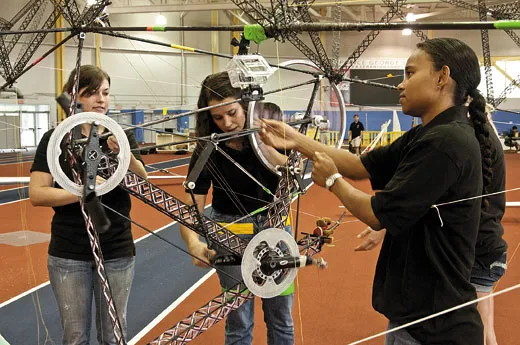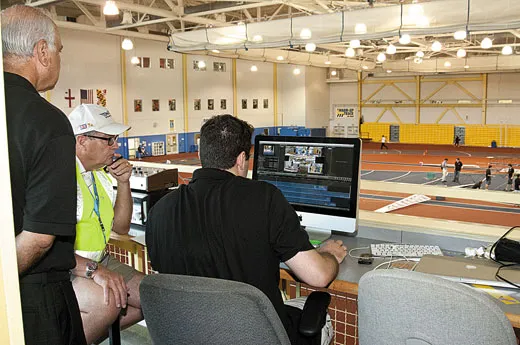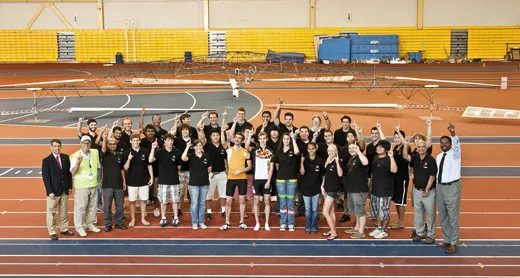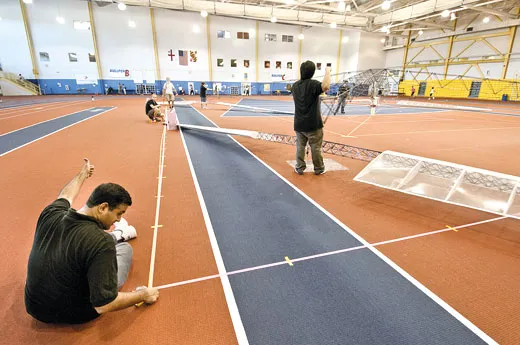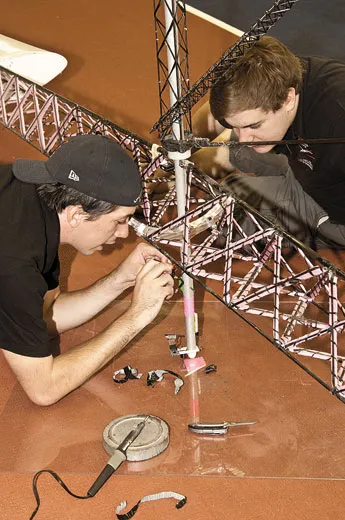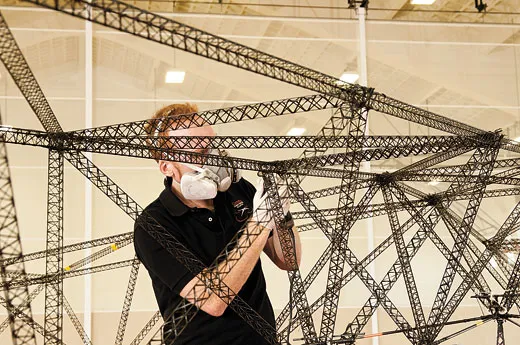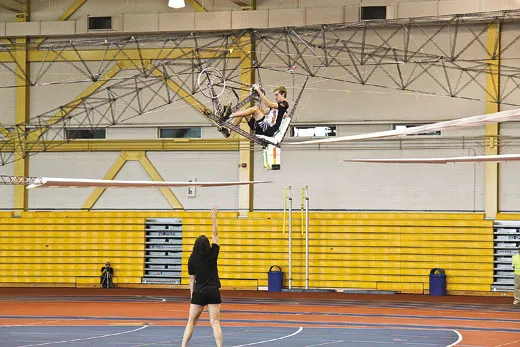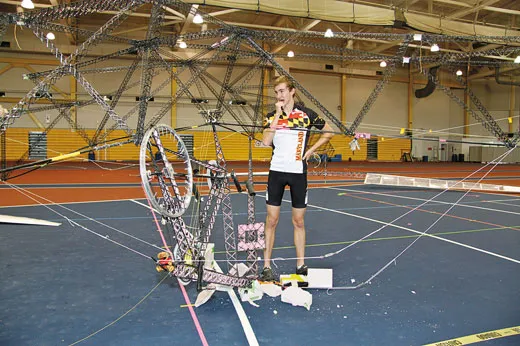University of Maryland Students Close in On The Human-Powered Helicopter Prize
Gamera is one of the few unusually made helicopters to have left ground.
/https://tf-cmsv2-smithsonianmag-media.s3.amazonaws.com/filer/Pedal-Power-Henry-631.jpg)
It was difficult to take in all at once: Four giant Mylar-covered rotors the size of windmill blades rotated, fishing line winding around a spool plinked like an untuned toy harp, and a vast, spidery structure trembled with the effort of a madly pedaling figure at its center. The pedaling figure turned the spool that wound the fishing line that worked the pulleys that drove the rotor blades. Late in the afternoon of May 4, 2011, no one was breathing in the University of Maryland gym.
I looked over at my 16-year-old son Tim. He had the camera on, capturing video. We’d first read about the machine that morning in the newspaper: a human-powered helicopter named Gamera (after a Japanese movie monster). We had dashed over, as soon as Tim got out of school. The article said that the team of students and faculty advisers who created Gamera were that day making their first attempts to fly, and right now, this very unusual helicopter was trying like hell.
At the center of the vehicle, near the cockpit, four students crouched, each one watching one of the four rotors intently, waiting to signal liftoff. First one hand went, then two more, then the fourth. The machine bobbed and inched itself off the gymnasium floor. For 4.2 seconds, everyone was transfixed. The pedaling slowed, the craft settled down, and the team went nuts—cheering, hugging, and spraying cheap champagne. Although they knew they were nowhere close to winning the prize they were aiming for, they had started. They could fly.
Gamera is not the first human-powered helicopter to do so. Others have tried, but very few have left the ground. All were in pursuit of the $20,000 Sikorsky Prize, first announced in 1980 by the American Helicopter Society and sponsored by Sikorsky Aircraft. To win, a machine must fly at least 60 seconds, reach an altitude of three meters (9.8 feet), and stay within a 10-meter (32.8-feet) square box—powered only by a single human.
Unlike fixed-wing aircraft, helicopters can’t produce lift without power. From one perspective, for a helicopter, a human is the worst conceivable source of power; a human being can barely generate enough oomph to offset his or her weight. But for those chasing the prize, that low power output makes the engineering all the more exciting. Solving the three fundamental design problems inherent in a human-powered helicopter requires extraordinary ingenuity. The design must maximize lift. With the low-power engine, small, high-speed rotors are impossible—so the machine will be large, with big, slow-turning rotors. The rotors must take maximum advantage of their position very close to the ground to reduce as much as possible the amount of power needed to leave it. The airframe must be strong enough to support itself and the weight of its human engine. Most critically, it must be extremely light.
In 1989, the first successful human-powered helicopter flight was made in a machine named Da Vinci III, built by a team at the California Polytechnic State University in San Luis Obispo and led by student Neal Saiki. The flight lasted eight seconds. The next milestone was reached at Nihon University in Japan, under the guidance of Akira Naito. In 1994, Naito’s Yuri-I left the ground for an astonishing 19.4 seconds. Fourteen years later, Gamera was born in College Park, Maryland.
In 2008, University of Maryland professor Fred Schmitz posed the high-weight/low-power feasibility of a human-powered helicopter to students as part of an exam, then raised the long-dormant Sikorsky Prize for discussion at a lunchtime meeting with his colleagues. Everyone had known about the prize for years, and knew of the previous attempts. Inderjit Chopra, head of the university’s rotorcraft center, had even experimented with models 30 years before. But a lot had changed, especially with computer-assisted design tools and simulations. Even the prize itself had changed: It is now worth $250,000.
Despite justifiable skepticism from several faculty members, Darryll Pines, then chair of the aerospace department, saw an opportunity, given a prevailing characteristic of Maryland students. “They have a slight chip on their shoulder,” says Pines. “They are as good [as students at other more prestigious universities], and they’ll work even harder, and they’ll beat you.” Pines has observed over the years that many of his engineering students labor to prove that they are as talented as the students at Ivy League schools. He cites their 2011 first place in the Solar Decathlon competition, beating out universities from around the nation and globe in building an affordable, efficient solar house. So he and the advisers appealed to that sense of pride: “We asked, ‘Do you want to be part of something really special: a first in flight? Why not us?’ ”
A large and enthusiastic group of students quickly coalesced around the quad-rotor design, similar to Yuri-I. Working mostly under wraps for the next two years, the team ran a series of tests investigating materials, structures, and performance, and based on results, designed the machine with several innovations: They invented “baby” trusses—both lighter and stronger than standard, off-the-shelf carbon-fiber tubes—to make up a significant portion of the larger structure. They created rotors that provide more total area than Yuri-I. And they gave the pilot/engine pedals to work with both hands and feet, instead of with feet alone. The goal at this stage was to simply get off the ground.
Virtually the only word that went out before Gamera’s first flights was a notice, posted around campus, advertising for pilots. Several hopefuls responded, but most were too big. Judy Wexler, Kyle Glusenkamp, and Colin Gore fit the bill: All weighed 135 pounds or less. All were competitive cyclists. Their training directive was simple: Pedal as fast and as long as you can.
In May 2011, after thousands of student hours and months of construction, Wexler muscled the giant fledgling into the air for the first time. It was a close call, both aerodynamically and logistically. To set up, assemble, and hope nothing went terribly wrong, the team had acquired permission to use the gymnasium for only a few days. The flight happened in the closing hours of their last day.
In July, the team got an opening to fly at the university’s armory building, and experienced their first crash. One of the transmission lines slipped off its pulley, a rotor lost lift, and Wexler came down—hard. She was fine, but Gamera’s trusses were mangled. A crew worked through the night to repair the vehicle. The next day, July 13, Wexler smashed her own record, going 11.4 seconds. As in May, an official observer from the National Aeronautic Association was present. Gamera officially became the human-powered helicopter world record-holder (Yuri I had had no official observer).
As satisfying as the recognition was, the real lesson was in the crash, and the team’s ability to respond. “The first time we crashed, we were heartbroken,” says Will Staruk, a lead student engineer. “The last time, no one cared, because we’ve never been stopped by something like that.” The students were gaining experience in what most aeronautical engineers dream of doing: flight testing.
In the small but energized world of human-powered vehicles, word of Gamera spread quickly. At that point, the team decided to publicize their efforts, posting videos on YouTube and inviting the media to their tests. None of it was lost on Cameron Robertson and Todd Reichert in Ontario, Canada. In 2010, they’d realized their own graduate student ambitions by creating and flying a human-powered ornithopter. In January, they established a group called AeroVelo to further explore the possibilities of human-powered vehicles. Inspired by Gamera and enticed by the prize, the two tackled a human-powered helicopter. Reichert would be the co-designer/engineer and the pilot. Based on their experience with the ornithopter, they were able to compress their development of a human-powered helicopter to five months.
As the Gamera team reviewed every aspect of their own design, they decided to build a whole new helicopter, with better transmission, more efficient rotors, and a lighter structure. They also learned that Neal Saiki, the first successful human-powered helicopter pilot, had begun his own pursuit of the Sikorsky Prize. His experience focused his approach: “It’s not so much the getting off the ground—it’s the stability,” says Saiki. His new ship was named Upturn. The race was on.
Gamera had taught its creators all it could, and the vehicle was set aside. After witnessing that first flight, I began working with the team to create an exhibit about the 2011 flights and the engineering challenge of a human-powered helicopter for the College Park Aviation Museum. The star of the exhibit is one of Gamera’s rotors, suspended from the ceiling. The helicopter had become a museum piece, and the students were fine with that. Its successor was well under way.
Gamera II came to life as computers crunched design and performance parameters, and the team made some big changes. They simplified the structure and slashed weight by using far more “baby” trusses, which had formed only part of the first Gamera’s structure. To provide more lift, they designed longer, tapered rotors with stiffer spars. And they added a flywheel to synchronize and smooth the formerly jerky pedaling done by the pilot’s hands and feet.
Up in Ontario, the AeroVelo team (populated mostly by volunteer students from the University of Toronto) christened their project Atlas and forged their own way. Also adopting the quad-rotor design, they incorporated the lightest known bicycle frame on the market. But to catch Gamera II, Atlas would have to hurry. As the summer of 2012 approached, the Atlas team began working around the clock, racing to get their first flights in before the end of August. Gamera II was already completed, with plenty of spare parts.
By now, the Gamera team had experienced a considerable ebb and flow: Older students departed, and younger ones joined. The team’s goal for its next flights was clear. “They had no intention of going for the prize,” says Pines. “None. Zip. Zero. They were just going to go for the [60-second] time.”
The new vehicle did not disappoint. Compared to its predecessor, Gamera II leapt into the air. In late June 2012, with an official observer from the National Aeronautic Association on hand, it turned in a series of record-destroying duration flights: 20, 35, 40, then 49.9 seconds (the last flown by Kyle Glusenkamp, and another official world record). Yuri-I’s 18-year reign was over; the 60-second mark was in view. A set of unofficial flights, some tethered, began to explore altitude, and Gamera II began to climb past three, then four feet.
Moving to a larger facility off campus in late August, the team improved the helicopter, extending the rotor blades and stiffening their tips. On August 28, I arrived at the indoor track in time to see Colin Gore make a duration attempt. He began pedaling, lifting easily into the air. As the blades spun, a familiar silence and tension descended; he kept flying, far longer than anything before. After an astonishing 65 seconds, he came down gently.
For the first time, a Sikorsky Prize marker had fallen. Once again, there were cheers, group photos, and elevated adrenaline. And then, later that afternoon, it was Henry Enerson’s turn to fly.
Enerson was an incoming freshman; he hadn’t yet attended his first class. A track athlete and rock climber, he also weighed 10 pounds less than Gore or Glusenkamp. He had already made a few flights, getting used to this new form of exertion. Now he was going to make an altitude attempt. Elizabeth Weiner, the team member who manages the pilots, half-jokingly turned herself into a human altimeter with brightly colored stripes taped across her jeans and shirt at one-foot intervals, so the others could get a quick measure of how Enerson did. Just for laughs, she taped her arms so that, stretched up, they could mark six feet.
Before Enerson’s flight, the team had the growing sense that the project might be reaching its limit. They’d set out to hit the one-minute mark, and that had just toppled. Pines and Chopra had discussed what appeared to be a threshold for how high Gamera II could go: somewhere above four feet. Enerson shocked them all.
Weiner stood next to the cockpit as Enerson began to pedal, tentatively holding one arm up in case he got higher than her waist. In seconds, he shot up over her head, then her completely outstretched arm. Enerson kept going—all the way to eight feet. Will Staruk shouted out the order to come down. After drifting backward for several feet, Enerson landed.
The gym erupted. Weiner collapsed to the floor in amazement. “We were in a state of shock,” says Pines. “How was he able to do that? What just happened?”
Suddenly, everything had changed. The Everest-like summit of the Sikorsky prize—the three-meter mark—was tantalizingly close. Any thought of the project winding down vanished, especially as everyone gathered to see the first video of Atlas leaving the ground in Ontario. The competition was real.
“It was definitely exciting,” says Atlas co-designer Robertson. “We were always thinking, How quickly do we need to progress? How quickly are they progressing?” Atlas clearly could fly, and had something Gamera did not: directional controls—specifically, the ability to pitch and roll. On a 15-second flight, Todd Reichert drifted out of the 10-meter box; using the controls for the first time, he came right back in. There was little word from California about Neal Saiki, but the Gamera II team knew that he’d flown too.
Back in Maryland, the team’s time in their rented space was running out—the three-meter mark could not wait. On August 30, I came to the recreation center as the team prepared. A series of short tuning flights took most of the day. As the afternoon became evening, the team’s confidence grew, buoyed by Gamera II’s steady performance and one of the most enormous pizza deliveries I’d ever seen. At about 9 p.m., Colin Gore was ready.
I stood at the far end of the gym, well out of the way, shooting pictures. Several students were nearby, carefully monitoring video cameras. Gore cranked Gamera II hard and flew straight up—even higher than Enerson. Through my viewfinder, I could see him heading down, and right for us. Fast. We had to run for it. The helicopter slid into the ground, bashing into a cameraman, one rotor striking the ground. With a huge crunch, Gamera II twisted itself up and collapsed onto the floor.
After several moments of stunned silence, the most remarkable thing happened. Rather than recoiling in shock and defeat, the team joyfully swarmed over the wounded machine, talking, pointing with amazement at the twisted wreckage, and tweeting pictures. Gore posed by a twisted truss with a goofy “Oops” grin and shrug. But it was a reaction reserved for everyone under the age of 30. Pines, Chopra, the NAA observer, every non-student, and I all stood there, arms crossed, with serious expressions. But the team instinctively knew they could handle the setback. They still had three whole days left in the gym.
And three days later, Gamera II was repaired, and Enerson was on deck. Tim and I came to see if they’d actually go for the prize. After hours of testing and trimming, Staruk gave the all clear, and Enerson rose, clearly higher than ever before. Staruk called at him to come down, and just like Colin, he started drifting. About four feet from the floor, Gamera II snapped with a hideous pop. Truss arms shot up in the air. Enerson was dumped onto the floor.
He was fine, but Gamera II was done—for now. Two of the repairs made after Gore’s crash had failed. The team’s time in the gym was over. But the altitude sensors had great news: Enerson had hit 2.87 meters, or 9.4 feet. They were less than six inches from the summit.
On a late September afternoon, the Gamera team gathered around a grill, just to hang out. The team continues to grow: My son has joined as an intern. Henry Enerson had another surprise: He walked into a team meeting followed by his identical twin brother, also an athlete, who quickly became a fourth engine. Pines gave the okay to go for the prize, and while new parts are built and broken ones replaced, the team’s renewed focus is on control. They hope to make a record-setting flight before the end of the year.
Robertson and Reichert in Ontario are building up funds for a second attempt, confident that their control system will keep Atlas in one spot. After several unpublicized flights, Neal Saiki gave Upturn, complete with its electronic control system, to his alma mater in San Luis Obispo. A new generation of Cal Poly students can enter the race.
Every team has its challenges, but all are confident about one thing: The Sikorsky Prize will soon be won.
Paul Glenshaw is director of the Discovery of Flight Foundation and co-producer of the 2009 documentary Barnstorming.
